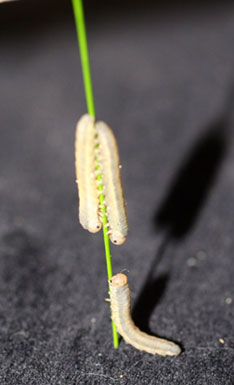Obscure turf pest shows up again in Southwest Michigan
Editor’s note: This article is from the archives of the MSU Crop Advisory Team Alerts. Check the label of any pesticide referenced to ensure your use is included.
Back in 2006, we received a sample of sawfly larvae from a lawn care service located in southwest Michigan. I was able to identify them as grass sawflies, Pachynematus sp. (Hymenoptera: Tenthredinidae). Mature larvae can be distinguished by their solid green color, amber head with a brown band and many legs. This sawfly has been reported as a minor pest of grass seed fields in Oregon. The University of Delaware lists them as an occasional pests of small grains. Tom Dudek, MSUE educator, sent me another sample of the same sawfly that a client of his collected in his lawn in Hudsonville.
Here is what is known about the grass sawfly. Its hosts include a number of grasses including wheat and barley, but they appear to favor the fine fescues over everything else. There is one generation per year. Adults emerge from the soil in late spring and lay eggs. The first larvae can be found by early May feeding on the lower leaf blades. Larval development takes approximately 21 to 30 days. By mid-June, larvae burrow into the ground and begin a period of summer hibernation in the prepupal stage.
The larvae resemble Lepidoptera caterpillars or foliage feeding cutworms at first glance. There are two easily recognizable characters that separate sawfly larvae from true caterpillars. Sawfly larvae have eight pairs of abdominal prolegs (fleshly little pegs) as compared to caterpillars which have no more than five pairs of these prolegs. Also sawfly larvae have a single, easy-to-see, large ocellus or simple eye on each side of the head whereas caterpillars have up to seven, difficult-to-see, ocelli arranged in a semi-circle on each side of the head.
Generally, these sawflies do not cause significant damage to crops or lawns because they are normally heavily parasitized by Icheumonid and Chrysidid wasps.



 Print
Print Email
Email





